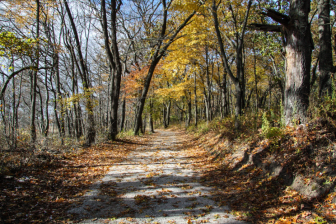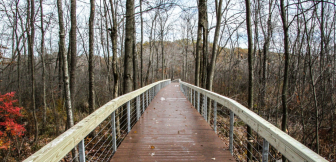
Cowles Bog Trail. Image: Victoria Stauffenberg/NPS
By Grace Jenkins
Indiana Dunes National Park is among the country’s five “lesser known national parks to add to your bucket list,” according to National Geographic.
With 2.7 million visitors in 2023, the park ranks 36th in attendance among 393 national parks, monuments and historic sites.
Credited for its striking plant and bird diversity, the park offers recreational and educational opportunities that many visitors enjoy, according to the National Park Service.
In 2019, what was then called the Indiana Dunes National Lakeshore became the state’s first national park.
Betsy Maher, the executive director of Save the Dunes, an environmental conservation organization based in Michigan City, Indiana, cited the effects that renaming the park has had on its popularity.
“The combination of 2020 with the pandemic and the name-change status caused a big boom in visitorship,” Maher said.
When the 2020 COVID-19 pandemic hit, visitors to other parks increased steadily, according to the Park Service. Despite a slight decrease in visitors as the world went back to normal, it has never dropped back to pre-pandemic levels.
“It’s wonderful that people rediscovered the natural world during that time, and that attention hasn’t let up.” Maher said.

A bridge along a trail in Indiana Dunes National Park. Image: Victoria Stauffenberg/NPS
Although Indiana Dunes is known to many Midwesterners, park service statistics show that people outside of the area may not have heard of the park.
According to National Geographic, other lesser known national parks included Hot Springs in Arkansas (ranked 39th most visited by the park service), Theodore Roosevelt in North Dakota (98th), Gates of the Arctic in northern Alaska (366th), and the National Park of American Samoa on the islands of Tutuila, Ta’ū and Ofu (358th).
Despite Indiana Dunes offering a view of the Chicago skyline, some people may find the surrounding urban area disappointing, said Bruce Rowe, a supervisory park ranger in the Division of Interpretation and Education.
“Some people are looking for national parks in more remote areas or with larger land masses,” Rowe said. “So, we do occasionally get people who are disappointed here.”
When asked about her favorite part of the park, Maher praised Mount Baldy, the tallest dune in the park, whose summit is 126 feet off the beach on Lake Michigan.
“The dune gives you breathtaking views of Lake Michigan. My kids and I love playing in the sand on the beach or finding clay. There are so many natural elements there that you can find all day long,” Maher said.
When asked about preservation efforts in the park, Rowe highlighted the black oak savanna, which is “one of the rarest habitats in the nation, with less than .02% of it still in existence.”
Black oak savanna, once covering 50,000 million acres from Michigan to Nebraska, now covers only 30,000 acres, according to the park service. Indiana Dunes National Park is home to over 1,000 acres of that remaining savanna.
The main tool to preserve the rare ecosystem is purposely setting contained fires to prevent the understory from growing up and shading the savanna.
“This park has an aggressive program of both prescribed fires and invasive species removal projects to preserve our native habitats and species,” Rowe said. “Fire is a critical tool in maintaining the black oak savanna.”
To increase accessibility and, in turn, attract more visitors, the park has wheelchair-accessible beaches, according to the park service.
In addition, Save the Dunes is working on accessibility grants to buy new elements for the park.
“We have about eight different accessibility projects going on currently, so we have a ton of things going on with the park,” Maher said. “We work with the park on increasing accessibility efforts to make sure that everyone can visit.”